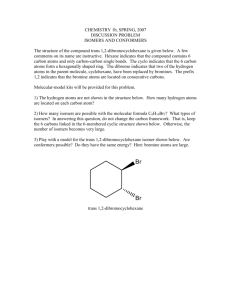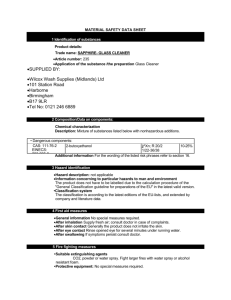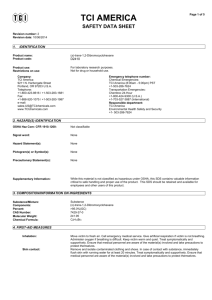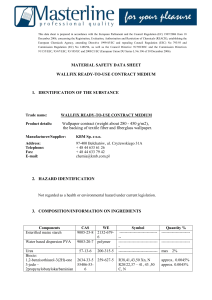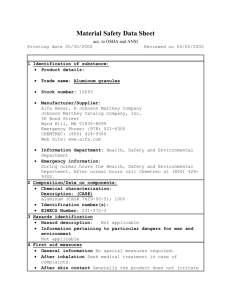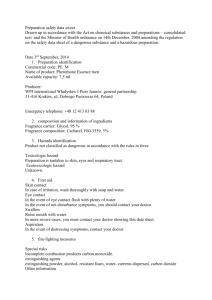SAFETY DATA SHEET 104590-1,2
advertisement
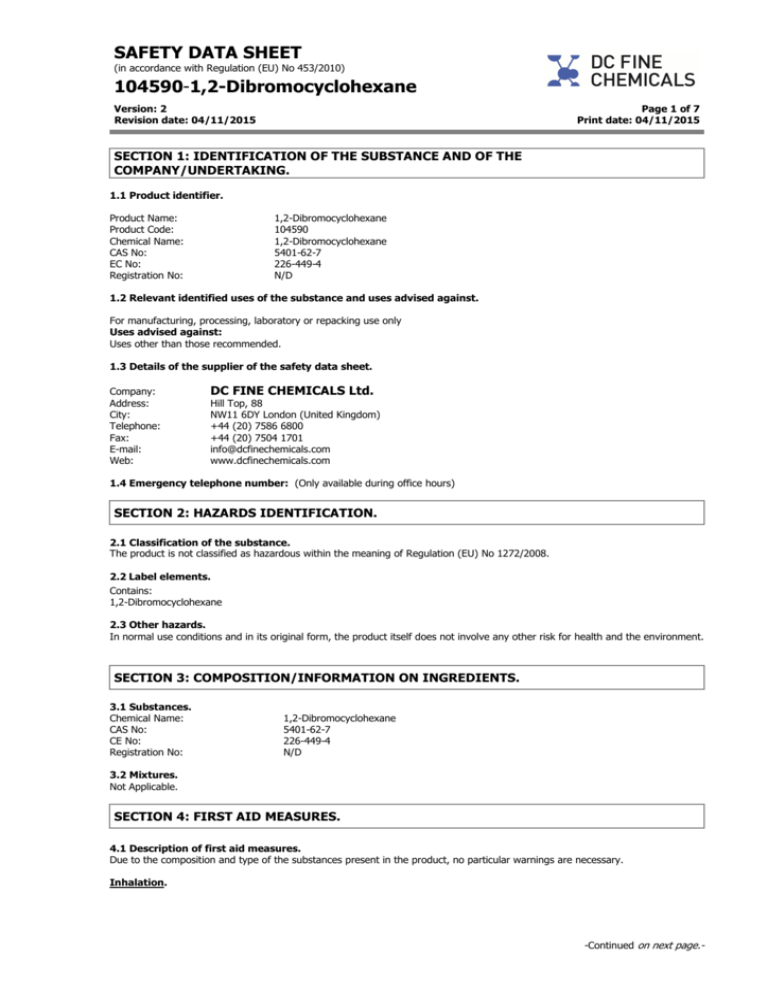
SAFETY DATA SHEET (in accordance with Regulation (EU) No 453/2010) 104590-1,2-Dibromocyclohexane Version: 2 Revision date: 04/11/2015 Page 1 of 7 Print date: 04/11/2015 SECTION 1: IDENTIFICATION OF THE SUBSTANCE AND OF THE COMPANY/UNDERTAKING. 1.1 Product identifier. Product Name: Product Code: Chemical Name: CAS No: EC No: Registration No: 1,2-Dibromocyclohexane 104590 1,2-Dibromocyclohexane 5401-62-7 226-449-4 N/D 1.2 Relevant identified uses of the substance and uses advised against. For manufacturing, processing, laboratory or repacking use only Uses advised against: Uses other than those recommended. 1.3 Details of the supplier of the safety data sheet. Company: Address: City: Telephone: Fax: E-mail: Web: DC FINE CHEMICALS Ltd. Hill Top, 88 NW11 6DY London (United Kingdom) +44 (20) 7586 6800 +44 (20) 7504 1701 info@dcfinechemicals.com www.dcfinechemicals.com 1.4 Emergency telephone number: (Only available during office hours) SECTION 2: HAZARDS IDENTIFICATION. 2.1 Classification of the substance. The product is not classified as hazardous within the meaning of Regulation (EU) No 1272/2008. 2.2 Label elements. . . Contains: 1,2-Dibromocyclohexane 2.3 Other hazards. In normal use conditions and in its original form, the product itself does not involve any other risk for health and the environment. SECTION 3: COMPOSITION/INFORMATION ON INGREDIENTS. 3.1 Substances. Chemical Name: CAS No: CE No: Registration No: 1,2-Dibromocyclohexane 5401-62-7 226-449-4 N/D 3.2 Mixtures. Not Applicable. SECTION 4: FIRST AID MEASURES. 4.1 Description of first aid measures. Due to the composition and type of the substances present in the product, no particular warnings are necessary. Inhalation. -Continued on next page.- SAFETY DATA SHEET (in accordance with Regulation (EU) No 453/2010) 104590-1,2-Dibromocyclohexane Version: 2 Revision date: 04/11/2015 Page 2 of 7 Print date: 04/11/2015 Take the victim into open air; keep them warm and calm. If breathing is irregular or stops, perform artificial respiration. Do not administer anything orally. If unconscious, place them in a suitable position and seek medical assistance. Eye contact. If wearing contact lenses, remove them. Wash eyes with plenty of clean and cool water for at least 10 minutes while pulling eyelids up, and seek medical assistance. Skin contact. Remove contaminated clothing. Wash skin vigorously with water and soap or a suitable skin cleaner. NEVER use solvents or thinners. Ingestion. If accidentally ingested, seek immediate medical attention. Keep calm. NEVER induce vomiting. 4.2 Most important symptoms and effects, both acute and delayed. No known acute or delayed effects from exposure to the product. 4.3 Indication of any immediate medical attention and special treatment needed. In case of doubt or when symptoms of feeling unwell persist, get medical attention. Never administer anything orally to persons who are unconscious. SECTION 5: FIREFIGHTING MEASURES. 5.1 Extinguishing media. Recommended extinguishing methods. Extinguisher powder or CO2. In case of more serious fires, also alcohol-resistant foam and water spray. Do not use a direct stream of water to extinguish. 5.2 Special hazards arising from the substance. Special risks. Fire can cause thick, black smoke. As a result of thermal decomposition, dangerous products can form: carbon monoxide, carbon dioxide. Exposure to combustion or decomposition products can be harmful to your health. 5.3 Advice for firefighters. Use water to cool tanks, cisterns, or containers close to the heat source or fire. Take wind direction into account. Prevent the products used to fight the fire from going into drains, sewers, or waterways. Fire protection equipment. According to the size of the fire, it may be necessary to use protective suits against the heat, individual breathing equipment, gloves, protective goggles or facemasks, and gloves. SECTION 6: ACCIDENTAL RELEASE MEASURES. 6.1 Personal precautions, protective equipment and emergency procedures. For exposure control and individual protection measures, see section 8. 6.2 Environmental precautions. Product not classified as hazardous for the environment, avoid spillage as much as possible. 6.3 Methods and material for containment and cleaning up. Pick up the spill with non-combustible absorbent materials (soil, sand, vermiculite, diatomite, etc.). Pour the product and the absorbent in an appropriate container. The contaminated area should be immediately cleaned with an appropriate decontaminator. Pour the decontaminator on the remains in an opened container and let it act various days until no further reaction is produced. 6.4 Reference to other sections. For exposure control and individual protection measures, see section 8. For later elimination of waste, follow the recommendations under section 13. -Continued on next page.- SAFETY DATA SHEET (in accordance with Regulation (EU) No 453/2010) 104590-1,2-Dibromocyclohexane Version: 2 Revision date: 04/11/2015 Page 3 of 7 Print date: 04/11/2015 SECTION 7: HANDLING AND STORAGE. 7.1 Precautions for safe handling. The product does not require special handling measures, the following general measures are recommended: For personal protection, see section 8. Never use pressure to empty the containers. They are not pressure-resistant containers. In the application area, smoking, eating, and drinking must be prohibited. Follow legislation on occupational health and safety. Keep the product in containers made of a material identical to the original. 7.2 Conditions for safe storage, including any incompatibilities. The product does not require special storage measures. As general storage measures, sources of heat, radiation, electricity and contact with food should be avoided. Keep away from oxidising agents and from highly acidic or alkaline materials. Store according to local legislation. Observe indications on the label. The product is not affected by Directive 2012/18/EU (SEVESO III). 7.3 Specific end use(s). SECTION 8: EXPOSURE CONTROLS/PERSONAL PROTECTION. 8.1 Control parameters. The product does NOT contain substances with Professional Exposure Environmental Limit Values.The product does NOT contain substances with Biological Limit Values. 8.2 Exposure controls. Measures of a technical nature: Provide adequate ventilation, which can be achieved by using good local exhaust-ventilation and a good general exhaust system. Concentration: 100 % Uses: For manufacturing, processing, laboratory or repacking use only Breathing protection: If the recommended technical measures are observed, no individual protection equipment is necessary. Hand protection: PPE: Protective gloves. Characteristics: «CE» marking, category II. CEN standards: Maintenance: Observations: Material: EN 374-1, En 374-2, EN 374-3, EN 420 Keep in a dry place, away from any sources of heat, and avoid exposure to sunlight as much as possible. Do not make any changes to the gloves that may alter their resistance, or apply paints, solvents or adhesives. Gloves should be of the appropriate size and fit the user's hand well, not being too loose or too tight. Always use with clean, dry hands. Breakthrough time Material thickness PVC (polyvinyl chloride) > 480 0,35 (min.): (mm): Eye protection: PPE: Characteristics: Face shield. «CE» marking, category II. Face and eye protector against splashing liquid. CEN standards: EN 165, EN 166, EN 167, EN 168 Maintenance: Observations: Skin protection: PPE: Characteristics: CEN standards: Maintenance: Visibility through lenses should be ideal. Therefore, these parts should be cleaned daily. Protectors should be disinfected periodically following the manufacturer's instructions. Make sure that mobile parts move smoothly. Face shields should offer a field of vision with a dimension in the central line of, at least, 150 mm vertically once attached to the frame. Protective clothing. «CE» marking, category II. Protective clothing should not be too tight or loose in order not to obstruct the user's movements. EN 340 In order to guarantee uniform protection, follow the washing and maintenance instructions provided by the manufacturer. -Continued on next page.- SAFETY DATA SHEET (in accordance with Regulation (EU) No 453/2010) 104590-1,2-Dibromocyclohexane Version: 2 Revision date: 04/11/2015 Observations: PPE: Characteristics: CEN standards: Maintenance: Observations: Page 4 of 7 Print date: 04/11/2015 The protective clothing should offer a level of comfort in line with the level of protection provided in terms of the hazard against which it protects, bearing in mind environmental conditions, the user's level of activity and the expected time of use. Work footwear. «CE» marking, category II. EN ISO 13287, EN 20347 This product adapts to the first user's foot shape. That is why, as well as for hygienic reasons, it should not be used by other people. Work footwear for professional use includes protection elements aimed at protecting users against any injury resulting from an accident SECTION 9: PHYSICAL AND CHEMICAL PROPERTIES. 9.1 Information on basic physical and chemical properties. Appearance:Liquid Colour: N.A./N.A. Odour:N.A./N.A. Odour threshold:N.A./N.A. pH:N.A./N.A. Melting point:N.A./N.A. Boiling Point: N.A./N.A. Flash point: N.A./N.A. Evaporation rate: N.A./N.A. Inflammability (solid, gas): N.A./N.A. Lower Explosive Limit: N.A./N.A. Upper Explosive Limit: N.A./N.A. Vapour pressure: N.A./N.A. Vapour density:N.A./N.A. Relative density:N.A./N.A. Solubility:N.A./N.A. Liposolubility: N.A./N.A. Hydrosolubility: N.A./N.A. Partition coefficient (n-octanol/water): N.A./N.A. Auto-ignition temperature: N.A./N.A. Decomposition temperature: N.A./N.A. Viscosity: N.A./N.A. Explosive properties: N.A./N.A. Oxidizing properties: N.A./N.A. N.A./N.A.= Not Available/Not Applicable due to the nature of the product 9.2. Other information. SECTION 10: STABILITY AND REACTIVITY. 10.1 Reactivity. The product does not present hazards by their reactivity. 10.2 Chemical stability. Stable under the recommended handling and storage conditions (see section 7). 10.3 Possibility of hazardous reactions. The product does not present possibility of hazardous reactions. 10.4 Conditions to avoid. Avoid any improper handling. 10.5 Incompatible materials. Keep away from oxidising agents and from highly alkaline or acidic materials in order to prevent exothermic reactions. 10.6 Hazardous decomposition products. No decomposition if used for the intended uses. -Continued on next page.- SAFETY DATA SHEET (in accordance with Regulation (EU) No 453/2010) 104590-1,2-Dibromocyclohexane Version: 2 Revision date: 04/11/2015 Page 5 of 7 Print date: 04/11/2015 SECTION 11: TOXICOLOGICAL INFORMATION. 11.1 Information on toxicological effects. Repeated or prolonged contact with the product can cause the elimination of oil from the skin, giving rise to non-allergic contact dermatitis and absorption of the product through the skin. Splatters in the eyes can cause irritation and reversible damage. a) acute toxicity; Not conclusive data for classification. b) skin corrosion/irritation; Not conclusive data for classification. c) serious eye damage/irritation; Not conclusive data for classification. d) respiratory or skin sensitisation; Not conclusive data for classification. e) germ cell mutagenicity; Not conclusive data for classification. f) carcinogenicity; Not conclusive data for classification. g) reproductive toxicity; Not conclusive data for classification. h) STOT-single exposure; Not conclusive data for classification. i) STOT-repeated exposure; Not conclusive data for classification. j) aspiration hazard; Not conclusive data for classification. SECTION 12: ECOLOGICAL INFORMATION. 12.1 Toxicity. No information is available regarding the ecotoxicity. 12.2 Persistence and degradability. No information is available about persistence and degradability of the product. 12.3 Bioaccumulative potencial. No information is available regarding the bioaccumulation. 12.4 Mobility in soil. No information is available about the mobility in soil. The product must not be allowed to go into sewers or waterways. Prevent penetration into the ground. 12.5 Results of PBT and vPvB assessment. No information is available about the results of PBT and vPvB assessment of the product. 12.6 Other adverse effects. No information is available about other adverse effects for the environment. SECTION 13 DISPOSAL CONSIDERATIONS. -Continued on next page.- SAFETY DATA SHEET (in accordance with Regulation (EU) No 453/2010) 104590-1,2-Dibromocyclohexane Version: 2 Revision date: 04/11/2015 Page 6 of 7 Print date: 04/11/2015 13.1 Waste treatment methods. Do not dump into sewers or waterways. Waste and empty containers must be handled and eliminated according to current, local/national legislation. Follow the provisions of Directive 2008/98/EC regarding waste management. SECTION 14: TRANSPORT INFORMATION. Transportation is not dangerous. In case of road accident causing the product’s spillage, proceed in accordance with point 6. 14.1 UN number. Transportation is not dangerous. 14.2 UN proper shipping name. Transportation is not dangerous. 14.3 Transport hazard class(es). Transportation is not dangerous. 14.4 Packing group. Transportation is not dangerous. 14.5 Environmental hazards. Transportation is not dangerous. 14.6 Special precautions for user. Transportation is not dangerous. 14.7 Transport in bulk according to Annex II of MARPOL 73/78 and the IBC Code. Transportation is not dangerous. SECTION 15: REGULATORY INFORMATION. 15.1 Safety, health and environmental regulations/legislation specific for the substance. The product is not affected by the Regulation (EC) No 1005/2009 of the European Parliament and of the Council of 16 September 2009 on substances that deplete the ozone layer. The product is not affected by Directive 2012/18/EU (SEVESO III). The product is not affected by Regulation (EU) No 528/2012 concerning the making available on the market and use of biocidal products. The product is not affected by the procedure established Regulation (EU) No 649/2012, concerning the export and import of dangerous chemicals. 15.2 Chemical safety assessment. There has been no evaluation a chemical safety assessment of the product. SECTION 16: OTHER INFORMATION. Sections changed compared with the previous version: 1,2,3,4,8,9,10,11,13,14,16 It is recommended that the product only be employed for the purposes advised. Abbreviations and acronyms used: CEN: European Committee for Standardization. PPE: Personal protection equipment. Key literature references and sources for data: http://eur-lex.europa.eu/homepage.html http://echa.europa.eu/ -Continued on next page.- SAFETY DATA SHEET (in accordance with Regulation (EU) No 453/2010) 104590-1,2-Dibromocyclohexane Version: 2 Revision date: 04/11/2015 Page 7 of 7 Print date: 04/11/2015 Regulation (EU) No 453/2010. Regulation (EC) No 1907/2006. Regulation (EU) No 1272/2008. The information given in this Safety Data Sheet has been drafted in accordance with COMMISSION REGULATION (EU) No 453/2010 of 20 May 2010 amending Regulation (EC) No 1907/2006 OF THE EUROPEAN PARLIAMENT AND OF THE COUNCIL of 18 December 2006 concerning the Registration, Evaluation, Authorisation and Restriction of Chemicals (REACH), establishing a European Chemicals Agency, amending Directive 1999/45/EC and repealing Council Regulation (EEC) No 793/93 and Commission Regulation (EC) No 1488/94 as well as Council Directive 76/769/EEC and Commission Directives 91/155/EEC, 93/67/EEC, 93/105/EC and 2000/21/EC. The information in this Safety Data Sheet on the Preparation is based on current knowledge and on current EC and national laws, as far as the working conditions of the users is beyond our knowledge and control. The product must not be used for purposes other than those that are specified without first having written instructions on how to handle. It is always the responsibility of the user to take the appropriate measures in order to comply with the requirements established by current legislation. The information contained in this Safety Sheet only states a description of the safety requirements for the preparation, and it must not be considered as a guarantee of its properties. -End of safety data sheet..-

